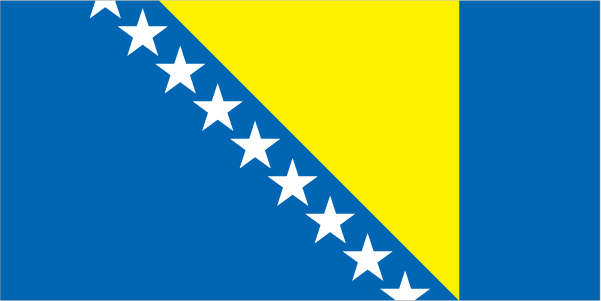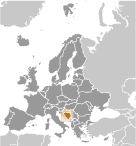
|
|
Advertisements:
EconomyEconomy - overview
Bosnia has a transitional economy with limited market reforms. The economy relies heavily on the export of metals as well as on remittances and foreign aid. A highly decentralized government hampers economic policy coordination and reform. The interethnic warfare in Bosnia and Herzegovina caused production to plummet by 80% from 1992 to 1995 and unemployment to soar. With an uneasy peace in place, output recovered in 1996-99 at high percentage rates from a low base; but output growth slowed in 2000-02. Part of the lag in output was made up during 2003-08, when GDP growth exceeded 5% per year. However, the country experienced a decline in GDP of nearly 3% in 2009 reflecting local effects of the global economic crisis. One of Bosnia's main economic challenges since the recession began has been to reduce spending on public sector wages and social benefits to meet the IMF's criteria for obtaining funding for budget shortfalls. Banking reform accelerated in 2001 as all the Communist-era payments bureaus were shut down; foreign banks, primarily from Austria and Italy, now control most of the banking sector. The konvertibilna marka (convertible mark or BAM) - the national currency introduced in 1998 - is pegged to the euro, and confidence in the currency and the banking sector has increased. Bosnia's private sector is growing, but foreign investment has dropped off sharply since 2007. Government spending, at roughly 50% of GDP, remains high because of redundant government offices at the state, entity and municipal level. Privatization of state enterprises has been slow, particularly in the Federation where political division between ethnically-based political parties makes agreement on economic policy more difficult. A sizeable current account deficit and high unemployment rate remain the two most serious macroeconomic problems. Successful implementation of a value-added tax in 2006 provided a predictable source of revenue for the government and helped rein in gray-market activity. National-level statistics have also improved over time but a large share of economic activity remains unofficial and unrecorded. Bosnia and Herzegovina became a full member of the Central European Free Trade Agreement in September 2007. Bosnia and Herzegovina's top economic priorities are: acceleration of integration into the EU; strengthening the fiscal system; public administration reform; World Trade Organization (WTO) membership; and securing economic growth by fostering a dynamic, competitive private sector. The country has received a substantial amount of foreign assistance and will need to demonstrate its ability to implement its economic reform agenda in order to advance its stated goal of EU accession. In 2009, Bosnia and Herzegovina undertook an International Monetary Fund (IMF) standby arrangement, necessitated by sharply increased social spending and a fiscal crisis exacerbated by the global economic downturn. The program aims to reduce recurrent government spending and to strengthen revenue collection. However, disbursement of IMF aid was suspended in 2011 after a parliamentary deadlock left Bosnia without a state-level government. In 2011, the country continued to recover from a recession caused by the global financial crisis. Unemployment and poverty are high. Ethnic and political stalemate slow reform and discourage investment. Bosnia relies heavily on West Europe for trade and credit. Gdp (purchasing power parity) World Ranking: 108
$32.04 billion (2011 est.)
$31.51 billion (2010 est.) $31.29 billion (2009 est.) Note Data are in 2011 US dollars Gdp (official exchange rate)
$17.97 billion (2011 est.)
Gdp - real growth rate World Ranking: 160
1.7% (2011 est.)
0.7% (2010 est.) -2.9% (2009 est.) Gdp - per capita (ppp) World Ranking: 124
$8,200 (2011 est.)
$8,100 (2010 est.) $8,000 (2009 est.) Note Data are in 2011 US dollars Gdp - composition by sector
Agriculture 8.3%
Industry 26.3% Services 65.4% (2011 est.) Labor force World Ranking: 109
2.6 million (2010 est.)
Labor force - by occupation
Agriculture 20.5%
Industry 32.6% Services 47% (2008) Unemployment rate World Ranking: 188
43.3% (2011 est.)
43.1% (2010 est.) Note Official rate; actual rate may be larger Population below poverty line
18.6% (2007 est.)
Household income or consumption by percentage share
Lowest 10% 2.7%
Highest 10% 27.3% (2007) Distribution of family income - gini index World Ranking: 84
36.2 (2007)
Budget
Revenues $8.435 billion
Expenditures $8.984 billion (2011 est.) Taxes and other revenues World Ranking: 27
47% of GDP (2011 est.)
Budget surplus (+) or deficit (-) World Ranking: 101
-3.1% of GDP (2011 est.)
Public debt World Ranking: 75
43.3% of GDP (2011 est.)
39.6% of GDP (2010 est.) Note Data cover general government debt, and includes debt instruments issued (or owned) by government entities other than the treasury; the data include treasury debt held by foreign entities; the data include debt issued by subnational entities, as well as intra-governmental debt; intra-governmental debt consists of treasury borrowings from surpluses in the social funds, such as for retirement, medical care, and unemployment. Debt instruments for the social funds are not sold at public auctions. Inflation rate (consumer prices) World Ranking: 88
3.7% (2011 est.)
2.1% (2010 est.) Commercial bank prime lending rate World Ranking: 120
7.43% (31 December 2011 est.)
7.89% (31 December 2010 est.) Stock of narrow money World Ranking: 100
$4.82 billion (31 December 2011 est.) $4.031 billion (31 December 2010 est.) Stock of broad money World Ranking: 108
$9.538 billion (31 December 2011 est.) $9.442 billion (31 December 2010 est.) Stock of domestic credit World Ranking: 98
$10.13 billion (31 December 2011 est.) $9.936 billion (31 December 2010 est.) Market value of publicly traded shares
$NA
Agriculture - products
Wheat, corn, fruits, vegetables; livestock Industries
Steel, coal, iron ore, lead, zinc, manganese, bauxite, aluminum, vehicle assembly, textiles, tobacco products, wooden furniture, ammunition, domestic appliances, oil refining Industrial production growth rate World Ranking: 97
3.1% (2011 est.)
Electricity - production World Ranking: 83
14.58 billion kWh (2009 est.)
Electricity - consumption World Ranking: 85
10.8 billion kWh (2009 est.)
Electricity - exports
3.9 billion kWh (2009 est.)
Electricity - imports
1.2 billion kWh (2009 est.)
Oil - production World Ranking: 122
59.36 bbl/day (2010 est.)
Oil - consumption World Ranking: 117
28,500 bbl/day (2010 est.)
Oil - exports World Ranking: 126
95.89 bbl/day (2009 est.)
Oil - imports World Ranking: 93
38,890 bbl/day (2009 est.)
Oil - proved reserves World Ranking: 109
0 bbl (1 January 2011 est.)
Natural gas - production World Ranking: 156
0 cu m (2009 est.)
Natural gas - consumption World Ranking: 98
390 million cu m (2010 est.)
Natural gas - exports World Ranking: 65
0 cu m (2010 est.)
Natural gas - imports World Ranking: 68
390 million cu m (2010 est.)
Natural gas - proved reserves World Ranking: 154
0 cu m (1 January 2011 est.)
Current account balance World Ranking: 134
-$1.583 billion (2011 est.)
-$1.009 billion (2010 est.) Exports World Ranking: 109
$6.03 billion (2011 est.)
$4.937 billion (2010 est.) Exports - commodities
Metals, clothing, wood products Exports - partners
Slovenia 18.3%, Croatia 15.1%, Italy 14.8%, Germany 13.9%, Austria 12.4% (2011) Imports World Ranking: 91
$11.06 billion (2011 est.)
$9.23 billion (2010 est.) Imports - commodities
Machinery and equipment, chemicals, fuels, foodstuffs Imports - partners
Croatia 20%, Germany 13.3%, Slovenia 13.1%, Italy 9.7%, Russia 7.7%, Austria 6.2%, Hungary 4.8% (2011) Reserves of foreign exchange and gold World Ranking: 96
$4.15 billion (31 December 2011 est.) $4.366 billion (31 December 2010 est.) Debt - external World Ranking: 92
$10.54 billion (31 December 2011 est.) $8.457 billion (31 December 2010 est.) Exchange rates
Konvertibilna markas (BAM) per US dollar - 1.4069 (2011 est.)1.4767 (2010 est.) 1.4079 (2009) 1.3083 (2008) 1.4419 (2007) Fiscal year
Calendar year
Comments
Add a new comment: |
Advertisement
Members area
Bosnia And Herzegovina (Sarajevo):
 
GPS points from Bosnia And Herzegovina (Sarajevo)
|
||||||||

 Bosnia and Herzegovina's declaration of sovereignty in October 1991 was followed by a declaration of independence from the former Yugoslavia on 3 March 1992 after a referendum boycotted by ethnic Serbs. The Bosnian Serbs - supported by neighboring Serbia and Montenegro - responded with armed resistance aimed at partitioning the republic along ethnic lines and joining Serb-held areas to form a "Greater Serbia." In March 1994, Bosniaks and Croats reduced the number of warring factions from three to two by signing an agreement creating a joint Bosniak/Croat Federation of Bosnia and Herzegovina. On 21 November 1995, in Dayton, Ohio, the warring parties initialed a peace agreement that brought to a halt three years of interethnic civil strife (the final agreement was signed in Paris on 14 December 1995). The Dayton Peace Accords retained Bosnia and Herzegovina's international boundaries and created a multi-ethnic and democratic government charged with conducting foreign, diplomatic, and fiscal policy. Also recognized was a second tier of government composed of two entities roughly equal in size: the Bosniak/Bosnian Croat Federation of Bosnia and Herzegovina and the Bosnian Serb-led Republika Srpska (RS). The Federation and RS governments were charged with overseeing most government functions. The Dayton Accords also established the Office of the High Representative (OHR) to oversee the implementation of the civilian aspects of the agreement. The Peace Implementation Council (PIC) at its conference in Bonn in 1997 also gave the High Representative the authority to impose legislation and remove officials, the so-called "Bonn Powers." In 1995-96, a NATO-led international peacekeeping force (IFOR) of 60,000 troops served in Bosnia to implement and monitor the military aspects of the agreement. IFOR was succeeded by a smaller, NATO-led Stabilization Force (SFOR) whose mission was to deter renewed hostilities. European Union peacekeeping troops (EUFOR) replaced SFOR in December 2004; their mission is to maintain peace and stability throughout the country. EUFOR's mission changed from peacekeeping to civil policing in October 2007, with its presence reduced from nearly 7,000 to less than 2,500 troops. Currently EUFOR deploys around 1,300 troops in theater.
Bosnia and Herzegovina's declaration of sovereignty in October 1991 was followed by a declaration of independence from the former Yugoslavia on 3 March 1992 after a referendum boycotted by ethnic Serbs. The Bosnian Serbs - supported by neighboring Serbia and Montenegro - responded with armed resistance aimed at partitioning the republic along ethnic lines and joining Serb-held areas to form a "Greater Serbia." In March 1994, Bosniaks and Croats reduced the number of warring factions from three to two by signing an agreement creating a joint Bosniak/Croat Federation of Bosnia and Herzegovina. On 21 November 1995, in Dayton, Ohio, the warring parties initialed a peace agreement that brought to a halt three years of interethnic civil strife (the final agreement was signed in Paris on 14 December 1995). The Dayton Peace Accords retained Bosnia and Herzegovina's international boundaries and created a multi-ethnic and democratic government charged with conducting foreign, diplomatic, and fiscal policy. Also recognized was a second tier of government composed of two entities roughly equal in size: the Bosniak/Bosnian Croat Federation of Bosnia and Herzegovina and the Bosnian Serb-led Republika Srpska (RS). The Federation and RS governments were charged with overseeing most government functions. The Dayton Accords also established the Office of the High Representative (OHR) to oversee the implementation of the civilian aspects of the agreement. The Peace Implementation Council (PIC) at its conference in Bonn in 1997 also gave the High Representative the authority to impose legislation and remove officials, the so-called "Bonn Powers." In 1995-96, a NATO-led international peacekeeping force (IFOR) of 60,000 troops served in Bosnia to implement and monitor the military aspects of the agreement. IFOR was succeeded by a smaller, NATO-led Stabilization Force (SFOR) whose mission was to deter renewed hostilities. European Union peacekeeping troops (EUFOR) replaced SFOR in December 2004; their mission is to maintain peace and stability throughout the country. EUFOR's mission changed from peacekeeping to civil policing in October 2007, with its presence reduced from nearly 7,000 to less than 2,500 troops. Currently EUFOR deploys around 1,300 troops in theater.